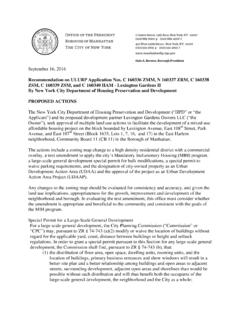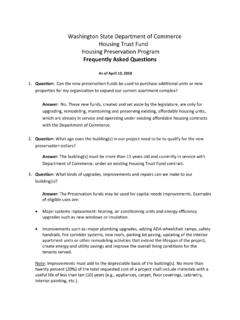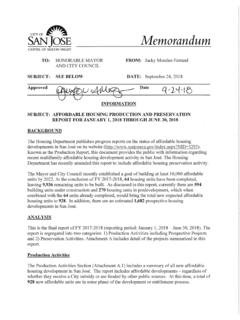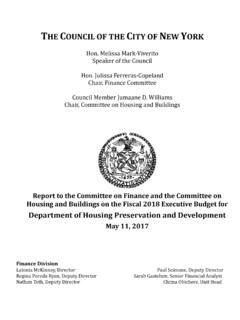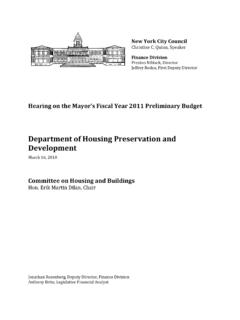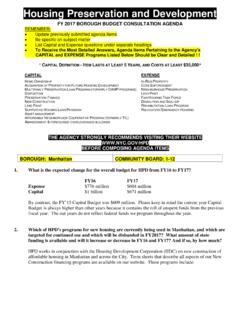Transcription of DEPARTMENT OF HOUSING PRESERVATION AND …
1 DEPARTMENT OF HOUSING PRESERVATION AND development Notice of Adoption Notice is hereby given that pursuant to the authority vested in the Commissioner of the De-partment of HOUSING PRESERVATION and development by Sections 1043 and 1802 of the City Charter, Section 23-96(k) of the Zoning Resolution, and Section 421-a of the Real Property Tax Law, the DEPARTMENT of HOUSING PRESERVATION and development is adopting amendments to Chapter 41 of Title 28 of the Rules of the City of New York (the "Inclusionary HOUSING Rules"). A notice of proposed rulemaking was published in the City Record on June 30, 2017. A pub-lic hearing was held on August 7, 2017. Written comments regarding the rules were received in accordance with the notice published in the City Record or electronically through NYC RULES at Comments were made available to the public within a reasonable time af-ter the hearing at Room No.
2 5-K2, 5th Floor, 100 Gold Street, between 10:00 am and 4:00 pm on weekdays. Statement of Basis and Purpose The rule amendments prohibit newly constructed affordable HOUSING units built to satisfy the re-quirements for tax exemption benefits pursuant to Real Property Tax Law Section 421-a(16) from generating floor area bonus for buildings other than either (a) buildings on the same zoning lot con-taining such affordable HOUSING units or (b) buildings on a development site on which such afforda-ble HOUSING units are located where such development site includes two or more zoning lots that were reviewed and approved as a single unit pursuant to the Zoning Resolution. Zoning Resolution Section 23-911, which governs the inclusionary HOUSING program, authorizes HPD to establish ad-ditional criteria for New Construction Affordable HOUSING through guidelines.
3 The City Planning Commission Report from this 2009 text amendment provides that [t]he availability of a range of options under the program including on-site and off-site; new construction, substantial rehabilita-tion, and PRESERVATION ; and rental and homeownership units serves to encourage the broadest possible participation in the Inclusionary HOUSING program, while a range of tax incentives and HOUSING subsidies strongly encourage affordable units to be located on-site. When the 2009 text amendments were adopted, it was with the understanding that 421-a and vol-untary inclusionary HOUSING would work together both to encourage on-site affordability and to en-sure that new developments participating in the inclusionary HOUSING program would generate af-fordable HOUSING units that would not otherwise have been constructed.
4 The changes to the 421-a program that took effect on April 10, 2017 undermine both of these assumptions. First, most condominium developments will not be eligible for the new 421-a program and will therefore not be subject to its on-site affordability requirements; therefore when condominium de-velopments want to obtain a zoning bonus for a larger building, they are unlikely to generate floor area by constructing on-site affordable units. Instead, for the reasons stated below, they will likely purchase zoning bonus generated by off-site rental affordable units from buildings participating in the new 421-a program. This rule would avoid this scenario. Second, while inclusionary HOUSING bonus can only be used in designated areas, the bonus floor area can be generated anywhere in the same community district as the receiving site or in an adja-cent community district within a half mile of the receiving site.
5 Rental buildings located anywhere in the City are eligible for the new 421-a program and must provide affordable units on the same zon- 2 ing lot which can be used to generate off-site inclusionary bonus. This increased supply of afforda-ble units, while welcome, will likely generate a glut of floor area bonus that will drive down the pur-chase price of off-site bonus. For condominium developments participating in the inclusionary HOUSING program, this glut of low cost floor area bonus will diminish both the incentive to build af-fordable units on-site, and the ability of the program to generate affordable units off-site that other-wise would not have been constructed in the absence of the inclusionary HOUSING requirements ( , they would already have been produced under the requirements of the new 421-a program).
6 These unintended effects of the new 421-a program undermine the assumptions about the interac-tion between tax incentives and inclusionary HOUSING that provided the foundation for the adoption of the 2009 text amendments and ultimately threaten the fundamental purpose of the inclusionary HOUSING program to create and support newly constructed affordable HOUSING . The rule amendments restore the validity of these assumptions. By limiting the zoning bonus that can be generated by such 421-a affordable units to usage in buildings on the same zoning lot or buildings within certain development sites with multiple zoning lots, buildings that require more floor area will have to provide on-site affordable HOUSING units or off-site affordable HOUSING beyond that already required by the new 421-a program. Pursuant to comments on the proposed rulemaking, Section 41-25 was altered to include devel-opment sites that include two or more zoning lots that were reviewed and approved as a single unit pursuant to the Zoning Resolution.
7 New material is underlined. [Deleted material is in brackets.] Shall and must denote mandatory requirements and may be used interchangeably in the rules of this DEPARTMENT , unless otherwise specified or unless the context clearly indicates otherwise. Section 1. Section 41-01 of Chapter 41 of Title 28 of the Rules of the City of New York is amended by adding one new definition to be inserted in alphabetical order and to read as follows: "Assisted Affordable Unit" shall have the meaning set forth for "Affordable HOUSING Unit" in Section 421-a(16)(a)(xv) of the Real Property Tax Law. 2. Chapter 41 of Title 28 of the Rules of the City of New York is amended by adding a new Section 41-25 to read as follows: Section 41-25. Limitations on Generation of Floor Area Compensation. For New Con-struction Affordable HOUSING , Assisted Affordable Units shall not generate any Floor Area Compensation for any Compensated development other than (a) a Compensated Devel-opment on the zoning lot on which such Assisted Affordable Units are located, or (b) a Compensated development on a development site on which such Assisted Affordable Units are located where such development site includes two or more zoning lots that were reviewed and approved as a single unit pursuant to the Zoning Resolution.
8

